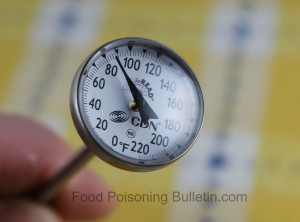Ever wonder about those leftovers in your fridge? You’re not alone. Because so many people have questions about the proper way to store leftovers, the U.S. Food and Drug Administration (FDA) has compiled some tips.
 One key tool for safe food storage is an appliance thermometer. These can be purchased at hardware or home improvement stores. Keep the refrigerator at 40 °F or below and the freezer at 0 °F or below.
One key tool for safe food storage is an appliance thermometer. These can be purchased at hardware or home improvement stores. Keep the refrigerator at 40 °F or below and the freezer at 0 °F or below.
Before putting food into the fridge, make sure it is clean. Wash shelves and drawers, discard expired items. If you aren’t sure about something, don’t sniff it, just throw it out. Make cleaning out the fridge part of your kitchen cleaning routine. Always wipe up spills right away.
Make sure you are not putting spoiled food into the fridge. This would include perishable food left out longer than two hours. At room temperature, bacteria that cause foodborne illness can double every 20 minutes.
When storing food, make sure it is in a covered or sealed container. And don’t jam-pack your fridge. Cold air has to be able to circulate around refrigerated foods to keep them properly chilled.
Even if you follow good food safety rules, like those outlined above, there is a limit on how long foods can keep. To see the FDA’s chart on the recommended shelf life of refrigerated and frozen foods, click here.





Great post!
As a working mom with 2 kids that are always on the go, we probably miss some of those dates easily. But I definitely do when in doubt throw it out, becuase it means I can’t remember when I last used it! Saving the information for my kids so they know when they can eat something or need to throw it out.